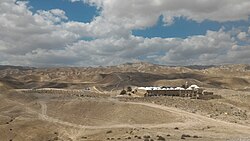Nebi Musa
| Nabi Musa | |
|---|---|
| Other transcription(s) | |
| • Arabic | نبي موسى |
| • Also spelled | an-Nabi Musa (official) Nebi Musa (unofficial) |
| • Hebrew | נבי מוסא |

Nabi Musa, 2017
|
|
| Location of Nabi Musa within the Palestinian territories | |
| Coordinates: 31°47′N 35°26′E / 31.783°N 35.433°ECoordinates: 31°47′N 35°26′E / 31.783°N 35.433°E | |
| Governorate | Jericho |
| Government | |
| • Type | Local Development Committee |
| Area | |
| • Jurisdiction | 122,248 dunams (122.2 km2 or 47.2 sq mi) |
| Population (2007) | |
| • Jurisdiction | 309 |
| Name meaning | "Prophet Moses" |
Nabi Musa (Arabic: نبي موسى, meaning the "Prophet Moses", also transliterated Nebi Musa) is the name of a site in the West Bank believed to be the tomb of Moses. It is also the name of a seven-day long religious festival that was celebrated annually by Palestinian Muslims, beginning on the Friday before Good Friday in the old Orthodox Greek calendar. Considered "the most important Muslim pilgrimage in Palestine", the festival centered on a collective pilgrimage from Jerusalem to what was understood to be the Tomb of Moses, near Jericho.
According to a census conducted in 1931 by the British Mandate authorities, Nabi Musa had a population of 3 males, in 1 house. A Palestinian village with the same name lies close to the site. In 2007, according to the census by the Palestinian Central Bureau of Statistics (PCBS), it had a residential population of 309.
The Jerusalem-Jericho road was one of the primary routes used by Mediterranean Arabs to make a pilgrimage to Mecca. The great, many-domed building which marks the Mausoleum of Moses was located at what would be have marked the end of the first day's march in that direction. Originally, it was simply a point from which pilgrims could look across the Jordan Valley and catch a glimpse of Mount Nebo where (as suggested by the Hebrew Bible) the tomb of Moses was thought to be located. It appears to have become a fixed point in the local Muslim calendar from the time of Saladin. In 1269 the Mamluk sultan Baibars al-Bunduqdari built a small shrine here, as part of a general policy he adopted after conquering towns and rural areas from Lebanon down to Hebron from the Crusaders. The shrines were mostly dedicated to biblical prophets and the companions of Mohammed, and their maintenance was funded by an awqaf, an endowment from properties that formerly belonged to the Latin Church. In the case of Nabi Musa, the waqf fund was secured from ecclesiastical assets expropriated in nearby Jericho.
...
Wikipedia

